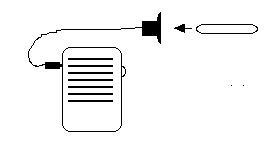
Bring a magnet toward the iron-cored coil and listen to the domain walls move.
Listen to the sound of one magnetic domain wall moving.
Introduction
An audio amplifier and a coil wound around a piece of iron will allow you to listen to the sounds made by moving magnetic domain walls as the iron becomes magnetized.
Material
A Radio Shack amplifier with built-in speaker, or equivalent amplifier and speaker
a Radio Shack telephone pick-up coil
a magnet such as a cow magnet
Assembly
Plug the pick-up coil into the amplifier
To Do and Notice
Turn on the amplifier until you can hear a gentle hiss then turn it down so that you cannot hear a hiss. Move one pole of the magnet toward the pick-up coil. Listen to the "sh" sound like static on a radio or television.

Move the magnet away. Notice the quieter sound as the magnet is moved away. At large distances there is no static sound. Move the magnet back in again notice that the sound is quieter. Remove the magnet, reverse it and move it in again. Notice the sound is loud again.
What's Going On?
The sound you are hearing is called white noise. It is the sound of static on unused television channels. In this exploration, the white noise is made up of thousands of pulses of sound. Each pulse is made when a domain wall inside the iron core of the pick-up coil moves. When the wall of a magnetic domain moves, it makes a sudden change in the magnetic field inside the coil of the pick-up coil. A changing magnetic field makes an electric current in the coil which the amplifier amplifies and turns into an audible sound.
The sound produced by domain wall motion is called the Barkhausen effect.
Iron atoms are all small magnets. The magnetic fields of these atoms are all aligned over regions in iron called magnetic domains. Domains with different directions of magnetization are separated by domain walls. When you bring a magnet toward a piece of iron, the domains which are aligned in the same direction as your magnet grow larger at the expense of their neighboring domains. To make a domain larger the domain wall moves. Impurity atoms in the iron or crystal edges can stop the domain wall until enough energy accumulates to push the domain wall past the impurity. The domain wall then moves suddenly and rapidly resulting in a rapid increase in the magnetization of the iron. The electric current in the coil flows when the magnetic field through the coil changes. The sudden motion of the domain walls in the iron produce pulses of electric current in the coil which are turned into sound by the amplifier and speaker.
Etc
Magnetic Domains were discovered by Weiss in 1926.
|
Scientific Explorations with Paul Doherty |
|
23 October 2002 |